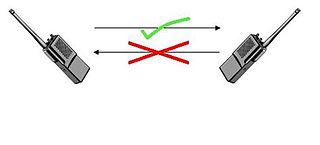
In geometry, a simplex is a generalization of the notion of a triangle or tetrahedron to arbitrary dimensions. Specifically, a k-simplex is a k-dimensional polytope which is the convex hull of its k + 1 vertices. More formally, suppose the k + 1 points are affinely independent, which means are linearly independent. Then, the simplex determined by them is the set of points

Linear programming is a method to achieve the best outcome in a mathematical model whose requirements are represented by linear relationships. Linear programming is a special case of mathematical programming.

Simplex communication is a communication channel that sends information in one direction only.

The flannel moths or crinkled flannel moths are a family of insects. They occur in North America and the New World tropics. The larvae are called puss caterpillars, and with their long hairs, resemble cotton balls. They have venomous spines that can cause a painful sting and inflammation lasting for several days. In some cases, the sting may cause headache, nausea, and shock-like symptoms. Perhaps the most notorious for stinging is the caterpillar of Megalopyge opercularis.

Herpes simplex virus1 and 2, also known by their taxonomical names Human alphaherpesvirus 1 and Human alphaherpesvirus 2, are two members of the human Herpesviridae family, a set of viruses that produce viral infections in the majority of humans. Both HSV-1 and HSV-2 are common and contagious. They can be spread when an infected person begins shedding the virus. About 67% of the world population under the age of 50 has HSV-1. In the United States more than one in six people have HSV-2. Although it can be transmitted through any intimate contact, it is one of the most common sexually transmitted infections.
The blue-collared parrot also known as simple parrot, lilac-collared song parrot, or lilac-collared Geoffroy's parrot, is a parrot found in the higher elevations of New Guinea. It is found from 500 to 2300 m, mainly between 800 and 1900 m. It is 23–25 cm, mainly green with a black beak, yellow wing bend, blue underwing coverts, and a pale yellow iris. Adult males have a blue collar across upper breast to lower neck above the mantle, adult females have some blue on the rear crown. Juveniles have no blue and a paler bill. There are two subspecies:

Poliovirus receptor-related 1 (PVRL1), also known as nectin-1 and CD111 (formerly herpesvirus entry mediator C, HVEC) is a human protein of the immunoglobulin superfamily (IgSF), also considered a member of the nectins. It is a membrane protein with three extracellular immunoglobulin domains, a single transmembrane helix and a cytoplasmic tail. The protein can mediate Ca2+-independent cellular adhesion further characterizing it as IgSF cell adhesion molecule (IgSF CAM).

Herpes simplex is a viral infection caused by the herpes simplex virus. Infections are categorized based on the part of the body infected. Oral herpes involves the face or mouth. It may result in small blisters in groups often called cold sores or fever blisters or may just cause a sore throat. Genital herpes, often simply known as herpes, may have minimal symptoms or form blisters that break open and result in small ulcers. These typically heal over two to four weeks. Tingling or shooting pains may occur before the blisters appear. Herpes cycles between periods of active disease followed by periods without symptoms. The first episode is often more severe and may be associated with fever, muscle pains, swollen lymph nodes and headaches. Over time, episodes of active disease decrease in frequency and severity. Other disorders caused by herpes simplex include: herpetic whitlow when it involves the fingers, herpes of the eye, herpes infection of the brain, and neonatal herpes when it affects a newborn, among others.
Microrape is a genus of moth in the family Megalopygidae.
Microrape camela is a moth of the family Megalopygidae. It was described by Walter Hopp in 1927. It is found in Colombia.
Microrape cristata is a moth of the family Megalopygidae. It was described by Walter Hopp in 1927. It is found in Brazil.
Microrape filata is a moth of the family Megalopygidae. It was described by Walter Hopp in 1927. It is found in Colombia.
Microrape gnathata is a moth of the family Megalopygidae. It was described by Walter Hopp in 1927. It is found in Peru.
Microrape hippopotama is a moth of the family Megalopygidae. It was described by Walter Hopp in 1927. It is found in Colombia.
Microrape signata is a moth of the family Megalopygidae. It was described by Walter Hopp in 1930. It is found in Brazil.
Microrape nivea is a moth of the family Megalopygidae. It was described by Walter Hopp in 1922. It is found in Bolivia.
Microrape santiago is a moth of the family Megalopygidae. It was described by Walter Hopp in 1922. It is found in Colombia.
Microrape jasminatus is a moth of the Megalopygidae family. It was described by Paul Dognin in 1893. It is found in Brazil, Bolivia and Ecuador.
Microrape minuta is a moth of the Megalopygidae family. It was described by Herbert Druce in 1886. It is found in Panama and Costa Rica.
Microrape shilluca is a moth of the Megalopygidae family. It was described by William Schaus in 1929. It is found in Brazil.








